
Workers prepare MUOS 4 for a scheduled launch. (ULA)
US Air Force (USAF) and US Space Force (USSF) officials are looking to mature narrowband satellite communications (NB satcom) capabilities as one of several ongoing efforts within the air service and elsewhere to transition from the Mobile User Objective System (MUOS) capability to a new NB satcom-driven architecture.
Proposed industry input in response to the 29 May White Paper solicitation from the USSF will inform efforts to “enable satellites to provide continued support of the NB satcom from a proliferated [medium earth orbit (MEO)] space segment”. Technology development efforts to allow NB satcom capabilities to be accessed via advanced end-user terminals, and not be limited to current MUOS terminals, create “an opportunity to increase space segment resiliency on the path to a more capable and resilient architecture”, USSF officials said in the solicitation.
MUOS is an information technology (IT)-based 3G communications protocol initially designed to replace legacy Ultra-High-Frequency (UHF) Follow-On satcom constellations as a way to close capability gaps in space-based tactical communications stemming from the UHF capability.
The key to the MUOS ability to deliver more than a ten-fold improvement in capacity, compared to the UHF, is that it adapts a wideband multiple access cellular phone network architecture, combining it with geosynchronous (GEO) satellites.
Air force leaders have begun leveraging MUOS to support secure NB satcom requirements at GEO for legacy elements of the USAF's fixed-wing fleet, such as the B-52 bomber. US Army leaders have also begun to incorporate MUOS capabilities into their mounted and dismounted operations.
Looking to read the full article?
Gain unlimited access to Janes news and more...
